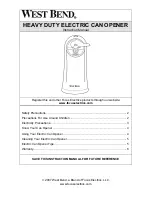
C4000I
47
532100 - Rev.A
Tr
ansla
tion of the original instruc
tions
ENGLISH
It is the responsibility of the machine installer/man-
ufacturer to draft the user instructions of the auto-
mation in accordance with the Machinery Directive,
including all the required information and instructions
based on the characteristics of the automation.
The guidelines below, which are purely indicative and
in no way exhaustive, help the installer draft the user
instructions.
!
The installer must provide the owner/operator of
the automation with the EC Declaration, the system
Logbook with the maintenance schedule and the user
instructions of the automation.
The installer must inform the owner/operator of any
residual risks and the intended use and ways in which
the machine should not be used.
The owner is responsible for operating the automation
and must:
- comply with all User instructions provided by the
installer/maintenance technician and the Safety
recommendations
- keep the user instructions
- have the maintenance schedule implemented
- keep the system Logbook, which must be com-
pleted by the maintenance technician at the end of
all servicing
14. INSTRUCTIONS FOR USE
14.1 SAFETY RECOMMENDATIONS
Installations using FAAC C4000I series gearmotors are
designed for use with vehicular traffic.
The user must be in good physical and mental health
and be aware of and responsible for the dangers which
use of the product can lead to.
!
- Do not remain in or walk/drive through the area
of operation of the automation while it is moving.
- Do not use the automation when the area of opera-
tion is not free of persons, animals or objects.
- Do not allow children to approach or play in the area
of operation of the automation.
- Do not try to prevent the movement of the auto-
mation.
- Do not climb on, hold onto or let yourself be pulled
by the leaf. Do not climb onto or sit on the gearmotor.
- Do not allow the devices to be used by anyone who
is not specifically authorised and trained to do so.
- Do not allow the devices to be controlled by children
or persons with mental and physical deficiencies un-
less they are supervised by an adult who is responsible
for their safety.
- Do not use the automation with the fixed and/or
mobile guards removed or altered.
- Do not use the automation in the presence of faults
which could compromise safety.
- Do not expose the automation system to corrosive
chemicals or atmospheric agents; do not expose the
gearmotor to water jets of any type or size.
- Do not expose the automation to flammable gases
or fumes.
- Do not perform any work on the components of
the automation.
14.2 PRODUCT WARNINGS
Risk of fingers and hands being trapped between the
rack, pinion and casing (§ 3.8-
2
).
14.3 EMERGENCY USE
Environmental phenomena, even occasional, such as
ice, snow and strong wind may hinder correct opera-
tion of the automation and affect component integrity
and may become a potential source of danger.
14.4 MANUAL OPERATION
!
Before performing the release operation, shut off the
power supply to the automation.
During manual operation, gently guide the leaf the
whole way. Do not push it and let it slide freely.
Do not leave the gate with the release engaged: after
moving it manually, restore automatic operation.
RELEASE PROCEDURE
1. Insert the release device and rotate it a quarter
turn, as shown in figure
34
-1
2. Move the barrier manually.
RESTORING AUTOMATIC OPERATION
1. I n s e r t t h e r e l e a s e d e v i c e a n d r o -
tate it a quar ter turn as shown in figure
34
-2
2. Make sure that the gate cannot be moved manually
and then remove the release device.
In emergencies or if there is a fault, turn off the power
supply to the automation and disconnect the buffer
batteries if there are any. If the leaf can be moved
safely by hand, use the MANUAL OPERATION mode;
otherwise place the automation out of service until it
has been reset/repaired.
In the case of a breakdown, the automation must be
reset/repaired exclusively by the installer/maintenance
technician.



































